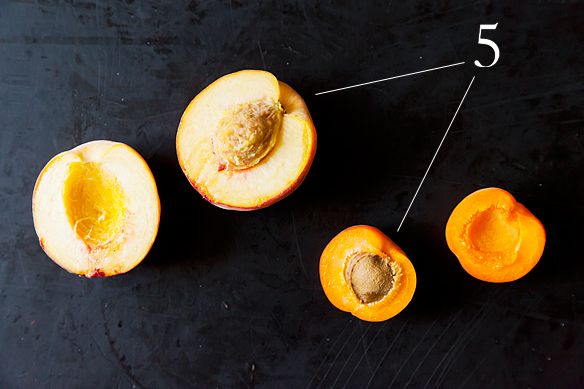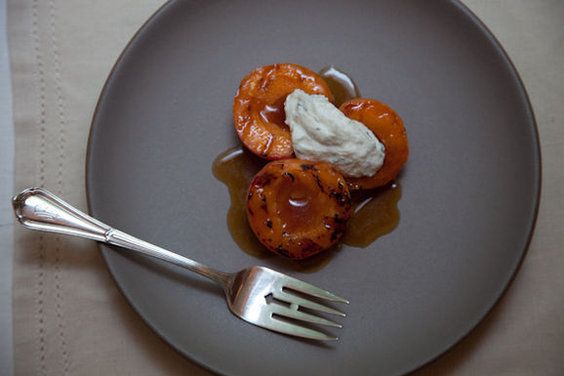Every week we get Down & Dirty, in which Nozlee Samadzadeh breaks down our favorite seasonal fruits, vegetables, and more by the numbers.
This week we're celebrating stone fruit -- any fruit with a fleshy exterior surrounding a shell that harbors a fruit seed. Does that sound complicated? Just think of peaches, apricots, plums, and nectarines: delicious flesh on the outside, hard pit on the inside, tiny seed inside of that. (Cherries, which we got down and dirty with last week, are also technically stone fruit!)
We'll be talking about all these together because they share many characteristics: all are grown on beautifully flowering trees and reach maturity in the late summer. They can be cooked in much the same way, too, and are adaptable to both sweet and savory recipes. Onward to the anything-but-stony palette of yellows, pinks, purples, and reds!

1. Apricots - With their coy red blush, orange flesh, and tiny size, apricots are easy to eat a lot of. They're also one of the oldest harvested fruits, with records of their cultivation going back to prehstoric times. (What's caveman for "apricot"?) The varieties we see in the US are all very similar -- no fuzz, unformly yellow-orange, and about the size of a golf ball -- but in Armenia, Turkey, Iran, and other parts of the Middle East, you can find dozens of varieties to purchase. If you can get your hands on a copy of Lucky Peach #2, Adam Gollner has an excellent article about the search for different apricot types: fuzzy, unfuzzy, dark, light, and everything in between.
2. Plums - There are two separate genuses of plum called Old World and New World -- the differences are mostly in how the flower stalks grow and at what rate. The plums that you see at the supermarket -- larger, with mottled purple skin and yellow or orange insides -- are Old World plums, as are smaller purple Italian plums and damson plums. New World plums include the yellow ones you see at farmers' market (and pictured here!) as well as other varieties of purple plums. While it's fun to buy as many types as you can for a side-by-side taste test, they're all interchangable in recipes.
3. Nectarines - Although they definitely taste different, nectarines are actually a subcategory of peaches! (The genetic trait towards a fuzzy outside is dominant, while smooth skin is recessive.) They tend to grow slightly smaller than peaches, and their lack of fuzz shows off their gorgeous red-orange skin. You can sub them in for peaches in any recipe, with a bonus: no peeling needed!
4. Peaches - Peaches are native to China, and spread across the world over the course of many centuries (many centuries -- from Greece in 300 BC to North America in the 16th century.) Their flesh can be yellow, usually sweeter and more acidic, or white, less sweet and more mellow. They grow well in any climate with mild winters and hot summers -- the South is especially known for great peaches, although the New Jersey peaches we find at market are pretty tasty, too.

5. It's the Pits - Stone fruit come in two varieties: freestone and clingstone. The first feels as miraculous -- just twist the fruit open and it's ready to eat or cook with -- as the other feels demonic -- what, you mean I have to carve the fruit away from this stone? The behavior of the stone inside has nothing to do with fruit taste, so if you'll be making plum cake or any other recipe that calls for pretty fruit halves, feel free to test your fruit at the market before buying.
Have you ever opened a stone fruit to find the stone split in half with a tiny white seed inside? That's the seed that will grow a new fruit tree. Usually the seeds are too bitter to use in cooking, but apricot and cherry seeds are small enough to be sweet and tender, with a taste reminiscent of almonds. This is why Merrill keeps the seeds in her Boozy Sour Cherries, and why Italian amaretto is actually brewed with apricot kernels instead of almonds. And you can find delicately scented apricot kernel oil in specialty stores -- it's used in soaps and cosmetics as well as in cooking.
We'll be dedicating next week to several stone fruit-centric recipe roundups. Here are three to keep you covered for now -- there are many more peach, nectarine, plum, and apricot recipes where these came from!




See what other Food52 readers are saying.